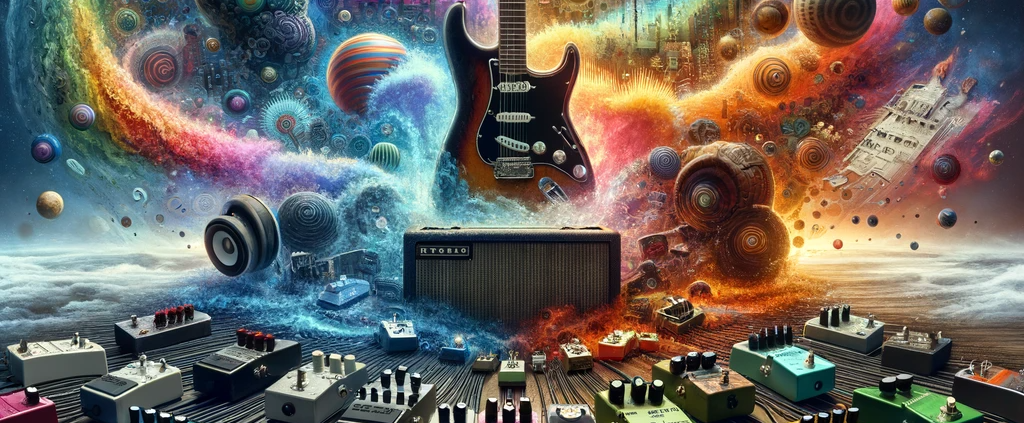Exploring Guitar Effects Pedals: Unleashing Sonic Creativity
Guitar effects pedals are like a palette of colors for a painter – they allow you to add layers, textures, and unique dimensions to your sound. From adding a touch of reverb to creating otherworldly sounds, effects pedals open up a world of sonic possibilities for guitarists. In this blog post, we’ll take you on a journey through the realm of guitar effects pedals, introducing you to various types and showing you how to incorporate them into your playing to elevate your musical expression.
What Are Guitar Effects Pedals?
Guitar effects pedals are compact devices that alter the sound of your guitar in real-time. They manipulate various aspects of your sound, such as tone, dynamics, and spatial qualities, to create diverse sonic landscapes. Effects pedals can be used individually or combined to achieve a unique signature sound.
Types of Effects Pedals
Distortion and Overdrive
These pedals add grit and crunch to your sound, simulating the sound of an overdriven tube amp or a high-gain amplifier. Distortion pedals provide a heavier, more aggressive sound, while overdrive pedals offer a smoother, warmer tone.
Delay
Delay pedals create echoes, simulating the effect of sound bouncing off walls. They can produce subtle ambient textures or create rhythmic patterns. By adjusting the delay time and feedback, you can create anything from a slight slapback to a cascading waterfall of sound.
Reverb
Reverb pedals replicate the sound of different spaces, from small rooms to vast cathedrals, adding depth and ambience to your sound. They can make your guitar sound like it’s being played in a concert hall or a cozy living room.
Chorus
Chorus pedals thicken your sound by duplicating it, slightly detuning the copy, and blending it back with the original. This creates a shimmering effect, making single notes and chords sound fuller and richer.
Wah-Wah
Wah pedals produce a distinctive “wah” sound by altering the frequency response of your guitar signal. They’re often used for expressive solos, allowing you to shape your sound dynamically by moving the pedal back and forth.
Phaser and Flanger
These pedals modulate the phase or time of your signal, creating sweeping and swirling sounds that add movement to your sound. Phasers produce a subtle, wavy effect, while flangers create a more pronounced jet-plane-like sound.
Tremolo
Tremolo pedals modulate the volume of your signal rhythmically, producing a pulsating effect that adds a dynamic element to your playing. This effect can range from a gentle wobble to a rapid stutter.
Incorporating Effects Pedals into Your Playing
Experimentation
Start by experimenting with one pedal at a time. Explore how each effect alters your sound and how it interacts with your playing style. Turn the knobs and switches to understand the full range of sounds each pedal can produce.
Layering Effects
As you become more comfortable, experiment with layering multiple pedals. For example, combining delay and reverb can create lush and atmospheric textures. Try stacking distortion with chorus or adding a phaser to a clean tone for a unique sound.
Creating Soundscapes
Effects pedals are excellent for creating ambient soundscapes. Use delay, reverb, and modulation effects to craft immersive sonic environments. Adjust the settings to make your guitar sound like it’s floating in space or echoing in a cavern.
Expressive Solos
Wah-wah and distortion pedals can add an expressive quality to your solos, allowing you to shape your sound dynamically. Use the wah pedal to emphasize certain notes and the distortion to add intensity and sustain.
Genre Exploration
Different effects are associated with different genres. Use distortion for rock, chorus for pop, and phaser for funk to explore new sonic territories. Experimenting with genre-specific effects can help you find your unique voice as a guitarist.
Conclusion
Guitar effects pedals are magical tools that allow you to paint your sonic canvas with a myriad of colors and textures. Whether you’re looking to add a touch of nostalgia, create ethereal soundscapes, or unleash blistering solos, effects pedals provide endless creative opportunities. By understanding the different types of pedals and experimenting with their combinations, you can personalize your sound, evoke emotions, and captivate your audience with a unique sonic journey that’s entirely your own. So go ahead, step into the world of guitar effects pedals, and let your creativity run wild!
—
Start your musical journey with a free trial lesson, available both online and in-person. Fill out this form and we’ll get back to you within 24 hours.



